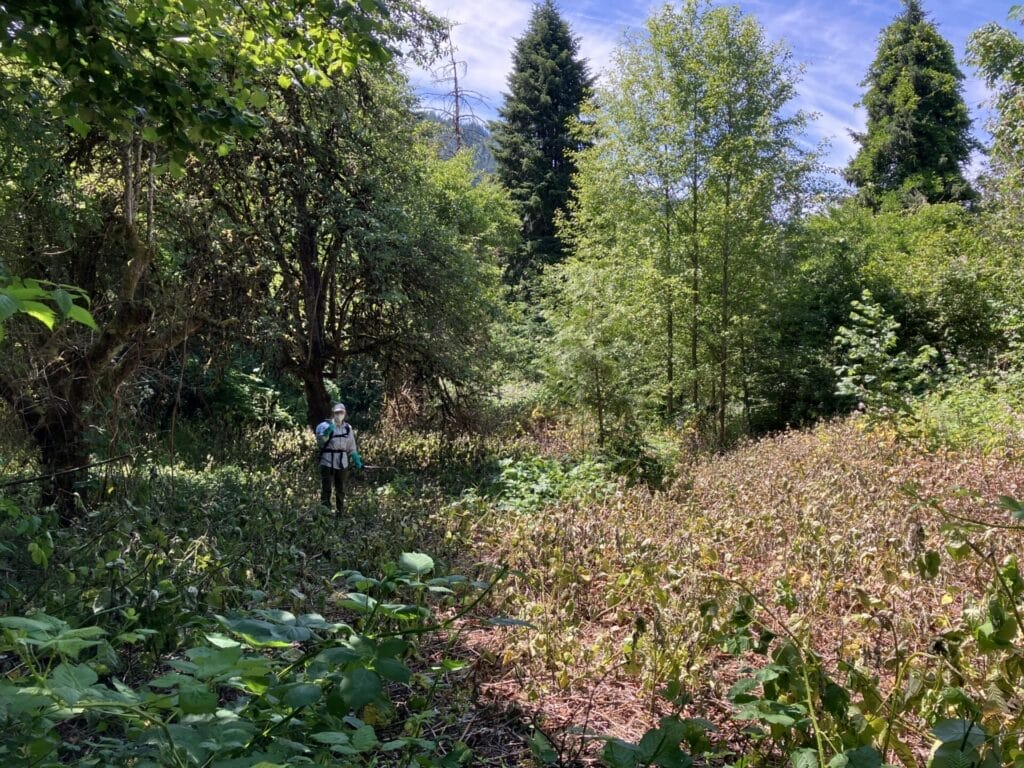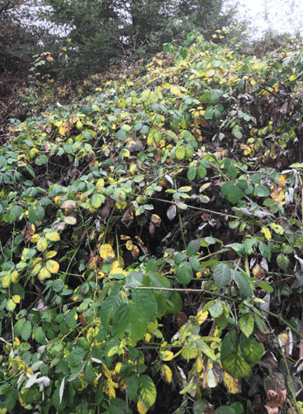Herbicide is one of the many tools used by restoration practitioners in the ecological restoration field. It is only applied by experience and licensed professionals, with the entire process being tightly regulated by state and federal laws, including the EPA
Noxious weeds cause significant damage to ecosystems and control methods are determined using an Integrated Pest Management (IPM) strategy which combines control methods to be most effective, while taking into account site type, size, and goals, along with target weed species, and other constraints. Most effective control methods can also vary by species, so Best Management Practices (BMPs; provided by the King County Noxious Weed Control Program) are followed when available. The cost of herbicide use is weighed against the damage that will occur if nothing is done.

There are some plant species where chemical control is the most effective option due to the nature of the plant growth. For example, knotweed is very hard to control without herbicide due to its complicated network of roots and ability to regrow from the smallest fragment left on a restoration site, making manual and mechanical control options less effective. Other weeds, such as Himalayan blackberry, can be removed manually by grubbing out the root balls or mechanically through mowing. However, these methods require significant time, resources, and funding, and may not be feasible due to site constraints. Herbicide, typically in combination with mowing, can also be the most effective means of controlling large areas of single weed species, also known as monocultures. Monocultures are detrimental to ecosystems because they prevent other species from growing, creating a lack in the diversity of habitat type and only provide a single food and pollination source at a specific time of year.
FAQ
Q: Why do we control these plants if they require herbicides?

A: Noxious weed species including introduced blackberry and knotweed are detrimental to ecosystems as they outcompete native species for space, sunlight, and nutrients. The goal of noxious weed control is to ultimately replace these species with native plants that benefit both humans and nature. This effort aims to reduce the impacts of introduced weeds and diversify and enhance the ecosystem to better support a functional habitat.
Q: Are herbicides harmful to people?
A: Safety is our top priority when applying herbicides! We always follow the label, along with state and local regulations, post herbicide notices in the area, and wear proper personal protective equipment (PPE) during application. We make sure to use the lowest concentrations for effective control and minimize the amount of herbicide going into the environment. If you see blue dye or herbicide notices, please avoid the area, as exposure may cause skin irritation or eye damage upon contact. It is safe to re-enter the site after 48 hours or as stated on the herbicide notice. It is best to avoid eating berries in an area you suspect herbicides have been used, this could include wilting plants or blue dye.

Q: How are you protecting pets and other wildlife?
A: One of the main goals of restoration is to provide more appropriate habitat for wildlife. Herbicides generally have a lower toxicity compared to other pesticides and we use the lowest effective concentrations. We also take extra precautions to avoid flowers to protect pollinators, work to avoid bird nesting season, use aquatically approved herbicides, and only apply in appropriate weather conditions. Regardless of herbicide use, it is recommended to keep dogs on leashes in known restoration areas.
Q: How are you protecting the water and salmon?
A: When using herbicide near waterways we obtain required permits, use aquatic approved formulas, low concentrations, apply only in appropriate weather conditions, avoid salmon spawning season, and minimize opportunities for herbicide to get into the water. Salmon recovery is a primary goal of our habitat restoration efforts, so we keep their wellbeing top of mind in everything we do!
Q: What chemicals are used when spraying herbicide?
A: Triclopyr and Imazapyr are the most common chemicals we use for treating blackberry and knotweed. Triclopyr and Imazapyr are the active ingredient names but may also be referred to by their brand names; we typically use Garlon 3A and Polaris. These are systemic herbicides which means they travel through the plant tissue to kill the entire plant, including the roots. This may cause the vegetative parts to twist and yellow before the death and decay of the plant. Both of these herbicides are aquatic approved, which means if they make their way into water, they will easily dilute. Rigorous testing by the EPA has concluded they should not negatively impact water quality or aquatic organisms. With that being said, we still take all proper precautions to keep herbicide out of waterways. A surfactant (brand name: Agridex) is also added to the spray mixture. It is used to help adhere the chemical to the plant, so it is more effective and doesn’t drip onto the soil or other plants. We use the lowest concentration possible to effectively stick to the target weed. Blue dye is used as an indicator to show areas that have been sprayed.
Q: Do you use herbicides year-round?
A: Herbicide is used year-round depending on the timing that’s most effective for the target plant species, the type of herbicide used, and the type of application. When spraying herbicide, warmer months tend to be the best time to avoid rain and allow enough time for the chemical to be effective before planting new vegetation.
Q: Who handles herbicides and who authorizes the use of herbicides? How can we know if they are being used responsibly?
A: The Washington State Department of Agriculture (WSDA) is responsible for ensuring herbicides are used safely and legally, while the Washington State Department of Ecology (WSDOE) is responsible for the National Pollutant Discharge Elimination System (NPDES) permits when herbicides may get into waterways. The Mountains to Sound Greenway Trust and Restoration Crew are all properly licensed by WSDA and post required herbicide notices where treatment occurs. Staff also attend trainings held by the King County Noxious Weed Control Program for ongoing updates on best management practices.






